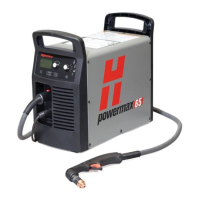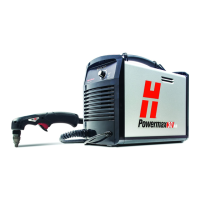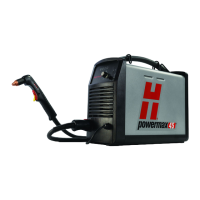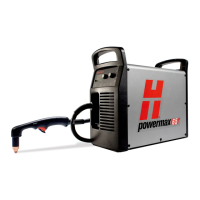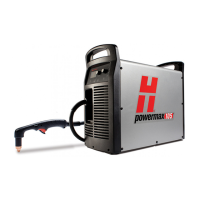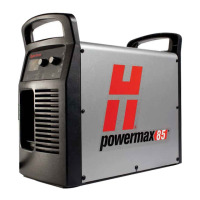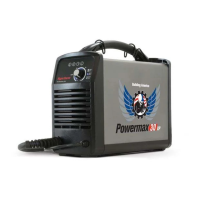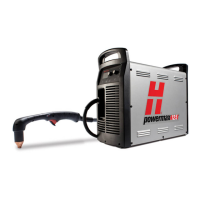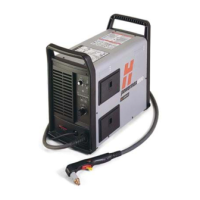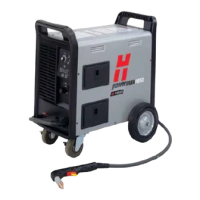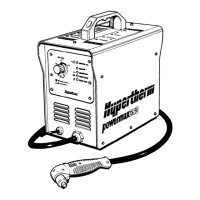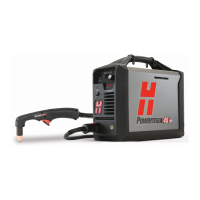Do you have a question about the Hypertherm powermax900 and is the answer not in the manual?
| Maximum Open Circuit Voltage (OCV) | 300 VDC |
|---|---|
| Input Power (CSA 3-PH) | 30-75 kW |
| Input Power (CE 3-PH) | 30-75 kW |
| Input Power (CSA 1-PH) | 25 kW |
| Input Power (CE 1-PH) | 25 kW |
| Output Voltage | 130 VDC |
| Duty Cycle @ 40° C | 100% |
| Duty Cycle | 100% @ 70 A |
| Max Cutting Thickness | 25 mm |
| Cutting Capacity (quality) | 20 mm (0.75 in) |
| Gas Supply | Air or Nitrogen |
| Gas Type | Air or Nitrogen |
| Torch Lead Length | 7.6 m (25') |
Explains compliance with EN50199 and user responsibilities for EMC.
Details user responsibility for setup, operation, and resolving disturbances.
Guides on assessing potential electromagnetic issues in the surrounding area.
Covers EMI reduction via mains supply, maintenance, and cable management.
Discusses bonding metallic components to minimize electrical risks.
Explains how earthing the workpiece can affect emissions.
Suggests methods for reducing interference through shielding.
Alerts users about using genuine Hypertherm parts to maintain warranty coverage.
Outlines the standard two-year warranty terms and conditions for products.
Details patent indemnity provisions related to product use and design.
Specifies limitations on implied warranties and liability for consequential damages.
States that national and local codes supersede manual instructions.
Guides on identifying and understanding safety symbols and hazards.
Emphasizes reading and adhering to all safety messages and labels.
Details fire and explosion prevention measures during cutting operations.
Provides precautions to prevent fatal electric shocks and burns.
Warns about hazardous fumes and gases produced during cutting.
Explains risks of injury from plasma arc and protective measures.
Details protection needed for eyes and skin from arc rays.
Covers essential grounding procedures for safe operation.
Provides safety guidelines for handling compressed gas equipment.
Highlights the danger of damaged compressed gas cylinders.
Advises on protecting hearing from prolonged noise exposure.
Discusses potential effects of magnetic fields on medical devices.
Lists references for further safety information and standards.
Introduces the topics covered in the specifications section of the manual.
Details electrical and physical specifications for the power supply unit.
Provides specifications for the PAC125T and PAC125M torch assemblies.
Details dimensions and specifications for the PAC125T hand torch.
Details dimensions and specifications for the PAC125M machine torch.
Explains the meaning of the S mark and its compliance requirements.
Defines various IEC symbols used throughout the manual for clarity.
Guides on verifying received parts and inspecting for shipping damage.
Outlines procedures for filing claims for damaged or missing merchandise.
Provides instructions and warnings for safely hoisting the power supply unit.
Details how to configure the power supply for different input voltages.
Specifies requirements for power cord plugs based on power supply type.
Provides tables for selecting the correct wire size for power cords.
Explains how to connect single-phase and three-phase power inputs.
Lists required power input voltages and corresponding fuse sizes.
Details essential grounding procedures for safety and EMI reduction.
Instructs on correctly attaching the work clamp for cutting operations.
Specifies requirements for air or nitrogen gas supply quality and pressure.
Guides on connecting the gas supply hose to the power supply filter.
Provides instructions for connecting the torch lead to the power supply.
Explains how to connect the ON/OFF pendant for machine torch control.
Describes how to align the machine torch for vertical cuts.
Details connecting the machine interface for arc transfer and start signals.
Explains how to connect an arc voltage cable for torch height control.
Describes the function of each control and indicator on the power supply.
Provides step-by-step guidance for operating the plasma cutting system.
Explains the functionality and use of the pilot arc controller option.
Details the operation of the safety trigger mechanism on the PAC125T torch.
Offers general advice for optimizing system performance and maintenance.
Provides instructions on how to replace worn consumable parts.
Guides on techniques and best practices for plasma cutting operations.
Explains the correct procedure for piercing material before cutting.
Details how to use the system for metal gouging operations.
Provides recommended settings for cutting various materials at 55 amps.
Provides recommended settings for cutting thin materials at 35 amps.
Lists common cutting problems and their potential causes and solutions.
Introduces the section on maintenance, troubleshooting, and parts.
Covers essential periodic maintenance tasks for the system.
Details how to drain the filter bowl and clean the filter element.
Explains how to access, clean, and replace the cooling air filter.
Provides a guide to diagnose and resolve common operational problems.
Directs users to further support for complex issues or detailed information.
Lists part numbers and descriptions for consumable parts kits.
Illustrates different consumable configurations for cutting and gouging.
Details parts for the PAC125T torch assembly with different lead lengths.
Lists parts for the PAC125M torch assembly with different lead lengths.
Lists available upgrade kits and optional parts for the system.
Details available power supply models for 208/240/480V systems.
Details available power supply models for 200/230/400V systems.
Details available power supply models for 400V CE systems.
Highlights shock hazard and safety procedures before changing fuses.
Lists publications related to plasma arc cutting equipment safety practices.
Explains the generation of hydrogen gas during aluminum cutting.
Provides instructions and a diagram for constructing an aeration manifold.
